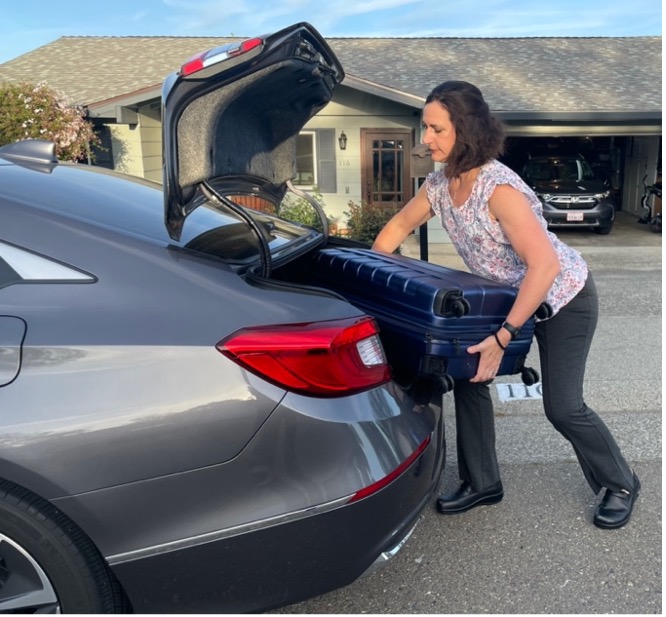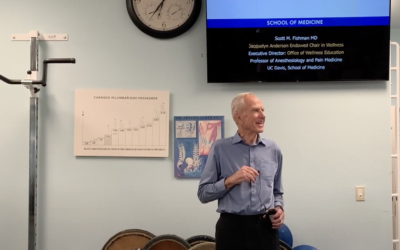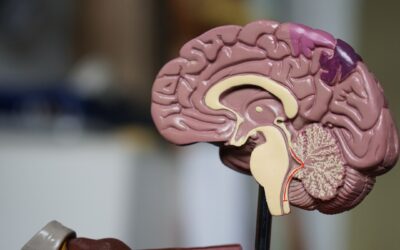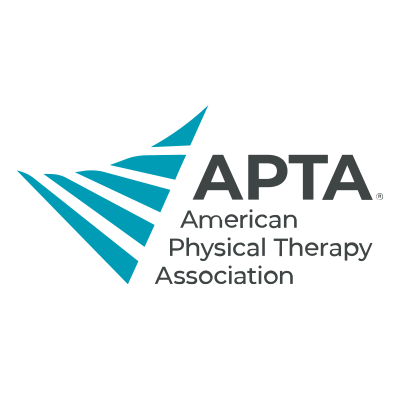By Brigit Lim, MPT
As pandemic restrictions lift, more people are planning vacations to see loved ones or just enjoying getting out to see the world. To help people enjoy themselves, we at FPT wanted to offer a few travel tips for helping people stay healthy on their vacations.
Safely Lifting Luggage:
If you are lucky enough to travel to a location where you are going to do a lot of activities, or just have kids, this could require packing a variety of clothing and footwear. If you are not used to lifting 30-50 lbs repetitively, and in potentially awkward movements such as in/out of car trunks or off of airport luggage carousels, then there could be potential for injury.
Luggage is not always a compact 30-50 lb parcel, but can be large and bulky, requiring two hands to lift. When people reach into a trunk with two hands they tend to flex down and round their back, and then twist trying to turn with the luggage to put it down on the ground. This places the lumbar spine in flexion and rotation which mechanically is the most frequent mechanism of injury for the lumbar discs and ligaments.
When lifting, keep your chest upright, your tailbone lifted up to the ceiling, and your spine in a straight line. Brace with your abdominals, gluteals and back muscles to stabilize against the weight of the luggage.
When turning with luggage to lift out of trunk or carousel, make sure to turn with hands and feet to avoid torsion in lower back.


Sleep:
Sleep is critical to enjoying a good vacation, but often you may be at the mercy of the type of mattress or pillow wherever you are staying. If you have lumbar issues, in addition to placing a pillow between your legs to keep your pelvis in neutral, you may have to place some support under your lumbar spine between the bottom of your ribcage and the top of your pelvis.
If a mattress is not supportive enough the lumbar goes into a side bending motion to meet the mattress and this can place the ligaments and soft tissues in the lumbar spine in enough static stretch, they become achy and irritable and can refer pain to the buttocks and hips. By placing a rolled towel or small pillow to support the lumbar spine into a more neutral plane this can allow for a more restful sleep. If you lie on your back to sleep and the mattress is too soft it can cause your back stay in too much sustained flexion, or rounding.
Conversely, too firm may not allow the body to sink in enough the mattress so the back stays in too much extension, or arching. To try to remedy the soft mattress, try to place small towel under the lower back to keep spine less flexion, for the firm mattress a small pillow under the lower gluteals and upper hamstring to create more flexion for the spine.
If you have neck issues, in side lying your goal is to make sure the pillow is supportive from the skull to the base of the neck and prevent side bending in either direction. If you are on your back, the pillow should go from the skull to the base of the neck allowing mild extension of neck, or mild chin up position, with the middle cervical firmly supported. Most people need different densities in pillows because often we need more height from a pillow to keep our necks in neutral when we are on our sides compared to on our backs.
Unfortunately, most hotels err on the side of having very overfilled pillows, so if you are a back sleeper it can be challenging to lay on your back and not get a headache from having your neck too flexed. You can try lying on a rolled bath towel when sleeping on your back and a regular pillow for side lying.
We also recommend people look into bring their own pillow, and one brand we like is Sachi pillow because their fill is buckwheat hulls which allows the individual to shape the pillow to their body depending on what type of sleeper they are. They make a travel size pillow that is 1.5 lbs and fits conveniently in luggage. You can purchase it here.
Car Travel:
Whether you are renting a car or driving your own but for much longer distances than normal, having a good car seat is paramount for decreasing neck, lumbar, and neural tension strain.
We at Folsom Physical Therapy recommend driving with the seat slightly reclined to decreased lumbar and cervical disc pressure. Ideally, your hands should be at the 4 and 8 o’clock position on the steering wheel and elbows should be by the sides of your rib cage to decrease strain on the rotator cuff and neural tension to the brachial plexus.
If the dashboard allows, you should scoot your seat up enough so that you simply have to shift your foot to access the gas and brake. This decreases strain on the hip and back muscles compared to having to lift the entire leg, even just 1 inch, repetitively to use gas and break. Of course, cruise control is amazing and you should use it if possible! Also, having the seat closer to the pedals allows for more knee flexion and therefore less sciatic neural tension.
Lastly, preferably there should be no hollow spaces. This means that while seated, allowing your spine to relax, you should feel the seat gives you support and keeps your spine in neutral. Often lumbar support in car is felt at the lower ribcage/upper lumbar, not at the waistline/upper buttock where most people have lumbar issues. Or the seat itself is so old that the buttocks sinks in too much causing sustained lumbar flexion. Two ways to remedy this would be to either place folded towels underneath each buttock, or place a small folded towel supporting the waistline area, or you may need both dependent on how sensitive your back is and how ill-fitting the seat.
To keep the cervical spine supported if the headrest does not fit you well, you can use a cervical travel pillow around your neck or a pillow attached around the supports of the head rest. When driving for long distances the goal is to have the head reclined back slightly to decrease cervical disc pressure and sustained muscle contraction from supporting the weight of the head.


In the picture on the right the torso is reclined and the neck supported to decrease gravitational stress on the cervical and lumbar discs/ muscles. Hands are at the 4 and 8 position allowing for her arms to stay relaxed by her sides therefore decreasing neural tension of upper quadrant and decreased sustained muscle contraction at shoulder and elbow.
Getting In Shape for Vacation:
Most of the time we think of vacations as a time to unwind, relax and do things for ourselves. We often don’t think of training for vacation. In the clinic we see people coming back from vacation having irritated tendons or joint issues from overdoing activities they were not in shape for. For example, most people who travel abroad to Europe have goals of taking tours of historical sites, museums or just enjoying the architecture. This could involve being on your feet for 1-4 hours a day on paved/unpaved ground, hills and stairs with or without railing.
In our opinion, if someone walks only 20 or 30 minutes at a time on paved level ground, they may need two months of training to get their body in shape for walking on uneven ground with hills or stairs for 1–2 hour durations. The goal is to gently allow tissues to toughen to the demands so there is not injury, and so you could walk longer durations at regular intervals on vacation without being too sore or exhausted.
Training can include walking on the treadmill at varying inclines if your neighborhood does not have hills, trying to use stairs without holding onto the rail if your balance allows for it, doing gentle leg and trunk strengthening for postural endurance to protect back, hips, knees and ankle, and flexibility to help decrease any muscle soreness.
We hope these travel tips help keep you safe and happy on your vacations. If you would like further guidance for sleep education, car seat eval, or training ideas for your vacation, you can contact us for an appointment at 916-355-8500 or fpt@folsomphysicaltherapy.com










